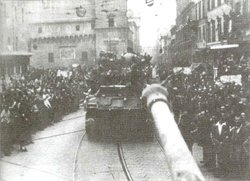Polish II Corps
|
|
2Corps_Insignia.jpg
Polish II Corps (Polish Drugi Korpus Wojska Polskiego, 1943-1947), was a major tactical and operational unit of the Polish Armed Forces in the West during World War II. It was commanded by Lieutenant General Władysław Anders and by 1945 it grew to well over 75,000 soldiers.
| Contents |
History
The Corps was created in 1943 from various units fighting alongside the Allies on all theatres of war. 3rd Carpathian Division was formed in Middle East from smaller Polish units fighting in Egypt and Tobruk, as well as Polish Army in the East evacuated from the USSR through the Persian Corridor. Its creation was based on British Army Act of 1940 that allowed the allied units of the exiled government of Poland to be grouped on one theatre of war. However, the British command never agreed to incorporate the Polish exiled Air force to be joined with the Corps.
Poles_Phantom_Hill.jpg
In 1944 it numbered about 50,000 soldiers. During the three subsequent battles the Corps suffered heavy losses (in the final stage of the Battle of Monte Cassino even the support units were mobilised and used in combat) and Gen. Anders was proposed to withdraw his units. However, since the Soviet Union broke diplomatic relations with the Polish government and no Poles were allowed out of the USSR, Anders believed that the only source of recruits was ahead - in German POW camps and concentration camps.
By 1945 new units were added composed mostly from freed POWs and Poles forced to join the Wehrmacht, increasing the amount of soldiers to approximately 75.000; approximately 20.000 of them were transferred to other Polish units fighting in the West. After the war the divisions of the Corps were used in Italy until 1946, when they were transported to Britain and demobilised. The majority of soldiers remained in exile.
Polish_Flag_Monte_Cassino3.jpg
Composition
In May 1945 the Corps numbered 55.780 men and approximately 1.500 women from auxiliary services. The forces were composed mostly of the Poles who were sent to Soviet GULags after the annexation of Eastern Poland in 1939. Following the Operation Barbarossa and the Sikorski-Mayski Agreement many of them were released and allowed to join the Polish Army in the East being formed in Southern Russia and Kazakhstan. Due to political reasons the Soviet Union soon withdrew support for the creation of Polish Army on its territory and lowered the supply rate, which forced general Władysław Anders to withdraw his troops to British-held Persia and Iraq. From there the troops were moved to British Mandate of Palestine, where they were joined with the 3rd Carpathian Division composed mostly of the Polish soldiers who managed to escape to French Lebanon through Romania and Hungary after the Polish Defence War of 1939.
The main bulk of the soldiers were from the eastern voivodships of pre-war Poland. Although the majority of them were ethnic Poles, there were also members of other nationalities who joined the units of 2nd Corps, most notably Jews, Belarusans and Ukrainians. After being relocated to Palestine, the Corps faced the problem of increased rate of desertions of soldiers of Jewish nationality, most of whom defected en masse to the Haganah. The most noted among them was Menachem Begin, the future Prime Minister of Israel. General Anders decided not to prosecute the deserters.
Polish_Bugler_Monte_Cassino.jpg
The armament was as follows:
- 248 pieces of artillery
- 288 anti-tank guns
- 234 anti-air guns
- 264 tanks
- 1.241 APCs
- 440 armoured cars
- 12.064 cars, Bren carriers and trucks
Losses
During the Italian Campaign the 2nd Polish Corps lost 11.379 men. Among them were 2301 KIA, 8543 WIA and 535 MIA.
OOB
- Polish 3rd Carpathian Infantry Division CO: Maj.Gen. Bronisław Duch
- 1st Carpathian Rifle Brigade
- 2nd Carpathian Rifle Brigade
- 3rd Carpathian Rifle Brigade (added in 1945)
- 12th Podolian Uhlan Regiment
- smaller divisional units
- Polish 5th Kresowa Infantry Division CO: Brig.Gen. Nikodem Sulik
- Polish 2nd Armoured Brigade (became Polish 2nd Warsaw Armoured Division in 1945). CO: Brig.Gen. Bronisław Rakowski
 Polish Tanks greeted by cheering crowds, enter Bologna.
Polish Tanks greeted by cheering crowds, enter Bologna.- 4th Armoured Regiment
- 6th Armoured Regiment
- 1st Krechowiecki Uhlan Regiment
- 14th Wielkopolska Armoured Regiment (added in 1945)
- 2nd Corps Artillery Group CO: Brig.Gen. Roman Odzierzyński
- Other Corps-level units
Poles_Americans_Bologna.jpg
See also:
- Polish contribution to World War II
- Polish government in exile
- Sikorski-Mayski Agreement
- 1st Polish Army
- 2nd Polish Army
- Piotra Sych
External link
- The Polish Soldier (http://www.mpvone.co.uk/polish/index.htm)pl:2 Korpus Polski
